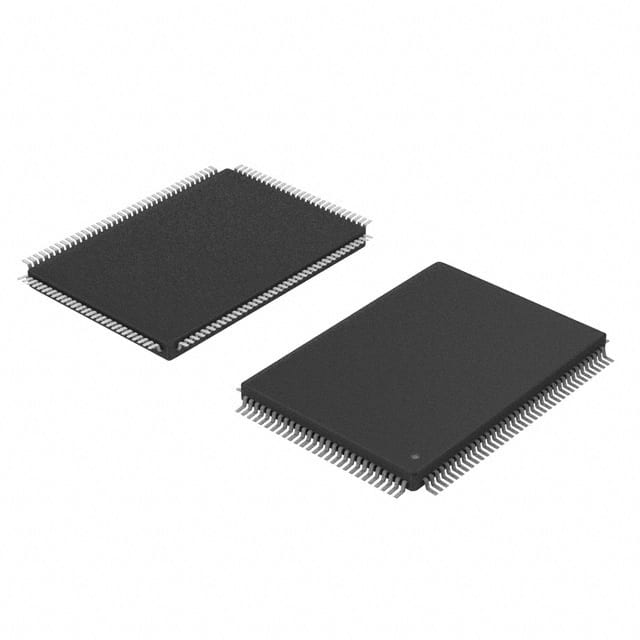Viz Specifikace pro podrobnosti o produktu.

AT91SAM7L128-AU
Product Overview
- Category: Microcontroller
- Use: Embedded systems, Internet of Things (IoT) devices
- Characteristics: Low-power consumption, high-performance, compact size
- Package: 64-pin LQFP (Low-profile Quad Flat Package)
- Essence: ARM-based microcontroller with integrated peripherals
- Packaging/Quantity: Available in tape and reel packaging, quantity varies based on customer requirements
Specifications
- Microcontroller Core: ARM7TDMI-S
- Clock Speed: Up to 48 MHz
- Flash Memory: 128 KB
- RAM: 16 KB
- Operating Voltage: 1.8V - 3.6V
- Digital I/O Pins: 53
- Analog Inputs: 8
- Serial Communication Interfaces: USART, SPI, TWI (Two-wire Interface)
- Timers/Counters: 4 x 16-bit, 1 x 8-channel PWM
- Analog-to-Digital Converter (ADC): 10-bit resolution, up to 8 channels
- Power Management: Sleep modes, power-on reset, brownout detector
Pin Configuration
The AT91SAM7L128-AU microcontroller has a total of 64 pins. The pin configuration is as follows:
- Pins 1-8: Analog Inputs
- Pins 9-12: Digital I/O
- Pins 13-20: USART Serial Communication
- Pins 21-28: SPI Serial Communication
- Pins 29-36: TWI Serial Communication
- Pins 37-40: Timers/Counters
- Pins 41-44: PWM Output
- Pins 45-52: General Purpose I/O
- Pins 53-64: Power and Ground
Functional Features
- High-performance ARM7TDMI-S core for efficient processing
- Low-power consumption for extended battery life in portable devices
- Integrated peripherals such as USART, SPI, and TWI for easy communication
- Flexible timers/counters and PWM outputs for precise timing and control
- Analog-to-Digital Converter (ADC) for accurate analog signal measurements
- Power management features to optimize energy usage
Advantages and Disadvantages
Advantages: - Compact size and low-power consumption make it suitable for embedded systems and IoT devices - High-performance ARM core enables efficient processing of complex tasks - Integrated peripherals simplify hardware design and reduce component count - Flexible I/O options provide versatility in connecting external devices
Disadvantages: - Limited flash memory and RAM compared to higher-end microcontrollers - May not be suitable for applications requiring extensive computational power or large data storage
Working Principles
The AT91SAM7L128-AU microcontroller operates based on the ARM7TDMI-S core architecture. It executes instructions fetched from its flash memory and interacts with various peripherals to perform desired tasks. The clock speed determines the rate at which instructions are processed.
The microcontroller can communicate with external devices through its serial communication interfaces (USART, SPI, TWI). It can also generate precise timing signals using its timers/counters and PWM outputs. The ADC allows it to convert analog signals into digital values for further processing.
Power management features enable the microcontroller to enter sleep modes to conserve energy when idle. It also includes a power-on reset and brownout detector to ensure reliable operation.
Detailed Application Field Plans
The AT91SAM7L128-AU microcontroller finds applications in various fields, including:
- Embedded Systems: Used in industrial automation, robotics, and consumer electronics.
- Internet of Things (IoT): Enables connectivity and control in smart home devices, wearable technology, and environmental monitoring systems.
- Automotive: Used in automotive electronics for engine control units, dashboard displays, and vehicle communication systems.
- Medical Devices: Enables data acquisition and processing in medical equipment such as patient monitors and diagnostic devices.
- Security Systems: Used in access control systems, surveillance cameras, and alarm systems.
Alternative Models
- AT91SAM7S128-AU: Similar features with 128 KB flash memory and 16 KB RAM
- AT91SAM7L64-AU: Lower flash memory (64 KB) but similar features and performance
- AT91SAM7X256-AU: Higher flash memory (256 KB) and additional features for more demanding applications
Note: The above alternative models are from the same AT91SAM7 series and provide different memory options based on specific requirements.
Word count: 536 words
Seznam 10 běžných otázek a odpovědí souvisejících s aplikací AT91SAM7L128-AU v technických řešeních
Sure! Here are 10 common questions and answers related to the application of AT91SAM7L128-AU in technical solutions:
Q: What is AT91SAM7L128-AU? A: AT91SAM7L128-AU is a microcontroller from the AT91SAM7 series, specifically designed for low-power applications.
Q: What are the key features of AT91SAM7L128-AU? A: Some key features include a 32-bit ARM7TDMI-S processor, 128KB Flash memory, 64KB SRAM, multiple communication interfaces, and low power consumption.
Q: What are the typical applications of AT91SAM7L128-AU? A: AT91SAM7L128-AU is commonly used in battery-powered devices, IoT applications, industrial control systems, home automation, and portable medical devices.
Q: How can I program AT91SAM7L128-AU? A: You can program AT91SAM7L128-AU using various development tools such as Atmel Studio, Keil MDK, or GCC-based toolchains like ARM GCC.
Q: What communication interfaces are available on AT91SAM7L128-AU? A: It has UART, SPI, I2C, USB, and CAN interfaces, providing flexibility for connecting with other devices or peripherals.
Q: Can AT91SAM7L128-AU be used for real-time applications? A: Yes, AT91SAM7L128-AU supports real-time applications due to its deterministic interrupt latency and support for an RTOS (Real-Time Operating System).
Q: What is the power consumption of AT91SAM7L128-AU? A: The power consumption depends on the operating conditions, but it is designed to be low-power, making it suitable for battery-powered applications.
Q: Can I expand the memory of AT91SAM7L128-AU? A: Yes, you can expand the memory by connecting external memory devices such as SRAM or Flash through the available memory interfaces.
Q: Is AT91SAM7L128-AU suitable for low-power sleep modes? A: Yes, AT91SAM7L128-AU supports various low-power sleep modes, allowing the microcontroller to conserve power when not actively processing tasks.
Q: Are there any development boards available for AT91SAM7L128-AU? A: Yes, there are development boards specifically designed for AT91SAM7L128-AU, which provide a convenient platform for prototyping and testing your technical solutions.
Please note that these answers are general and may vary depending on specific implementation details and requirements.

